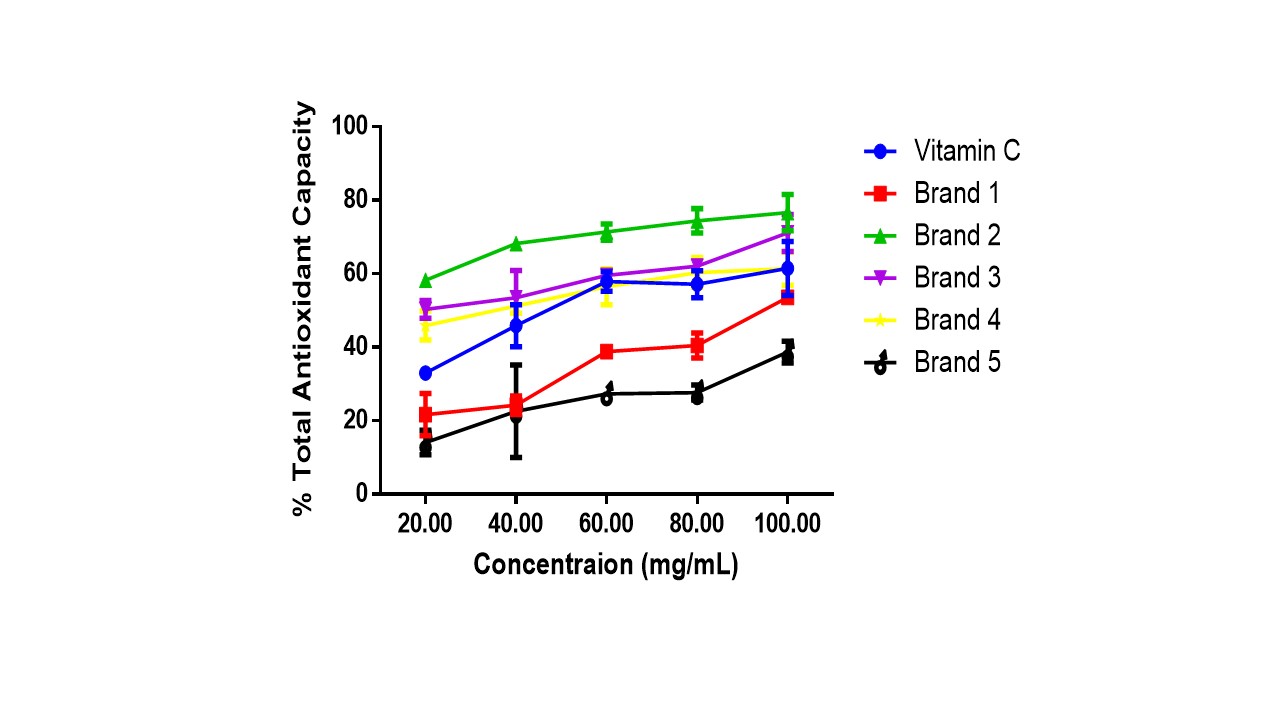Evaluation of in vitro antioxidant activities of selected commercial tea brands
DOI:
https://doi.org/10.54117/gjpas.v1i1.1Keywords:
Tea, Antioxidant, Natural Product, Oxidative Stress, Commercial tea brandsAbstract
The generation of reactive oxygen species requires the availability of antioxidants to ensure a balance between oxidants and prooxidants. Teas are commonly consumed due to their beneficial antioxidant effects. This study evaluated the in vitro antioxidant effects of aqueous and ethanol extracts of five selected commercial tea brands using ascorbic acid as the reference standard. The results showed that total antioxidant capacity (TAC) of aqueous extract of brand 1 was significantly lower (p<0.05) compared to brand 2 with half maximal inhibitory concentration (IC50) values of 96.82 and 25.60 mg/mL respectively while the ethanol extract of all tea brands (IC50 values between 53.94 to 120.40 mg/mL) were significantly lower (p<0.05) to vitamin C with IC50 of 22.72 mg/mL. In the ferric ion reducing antioxidant property (FRAP), four of the tea brands expressed none significant FRAP activities with IC50 values between 12.84 and 14.97 mg/mL compared with vitamin C with IC50 values of 17.16 mg/mL, while the ethanol extract of the brand expressed none significant FRAP activities at higher concentrations. Hydrogen peroxide scavenging activities of aqueous and ethanol extracts of all tea brands were significantly lower (p<0.05) with IC50 values between 20.23 - 44.56 mg/mL and 30.53 - 36.01 mg/mL compared with vitamin C with IC50 values of 13.72 and 15.69 mg/mL respectively. Similarly, 2,2-diphenyl-1-picrylhydrazyl (DPPH) scavenging property of aqueous extracts of all brands were significantly lower (p<0.05) compared with vitamin C with IC50 values of 12.92 mg/mL. Furthermore, the nitric oxide scavenging property of aqueous extracts of three brands (IC50 = 18.65, 24.69 and 24.80 mg/mL) were significantly higher (p<0.05) than vitamin C (IC50 = 37.75 mg/mL), while ethanol extract of three brands (IC50 = 12.81, 12.84 and 13.89 mg/mL) were significantly higher (p<0.05) than vitamin C (IC50 = 32.80 mg/mL). The results of the study indicated that the selected commercial tea brands possess in vitro antioxidant properties with potential benefits of the removal of free radicals and thus the prevention of oxidative stress.
References
Babu, P.V., Sabitha, K.E., Shyamaladevi, C.S. (2006). Therapeutic effect of green tea extract on oxidative stress in aorta and heart of streptozotocin diabetic rats. Chem Biol Interact. 162:114-120.
Belitz, D.H. and Grosch, W. (1997). Quı’mica de los Alimentos Zaragoza: Acribia.
Bruneton, J. (2001). Pharmacognosie. Phytochimie. Plantes Me’dicinales Paris: Technique Documentation-Lavoisier.
Chacko, S.M., Thambi, P.T., Kuttan, R., Nishigaki, I. (2010). Beneficial effects of green tea: A literature review. Chinese Medicine. 5:13.
Chan, E.C., Tie, P.P., Soh, E.Y., Law, Y.P. (2011). Antioxidant and antibacterial properties of green, black, and herbal teas of camellia sinensis. Pharmacognosy Res. 3:266-72.
Dufresne, F. and Mukamal, C.E. (2008). Coffee, cocoa and tea. New York: CABI Publishing.
Fiorentino, A., Ricci, A., D’Abrosca, B., Pacifico, S., Golino, A., Letizia, M., et al. (2008). Potential food additives from Carex distachya roots: Identification and in vitro antioxidant properties. J Agric Food Chem. 56: 8218-25.
Girgih, A.T., Udenigwe, C.C., Aluko, R.E. (2013). Reverse-phase HPLC separation of hemp seed (Cannabis sativa L.) protein hydrolysate produced peptide fractions with enhanced antioxidant capacity. Plant Foods Hum Nutr. 68: 39-46.
Graham, H.N. (1992). Green tea composition, consumption, and polyphenol chemistry. Prev Med. 21:334-350.
Hu, G., Bidel, S., Jousilahti, P., Antikainen, A. and Tuomilehto, J. (2007). Coffee and tea consumption and the risk of Parkinson’s disease. Movement Disorder. 22: 2242–2248.
Ifemeje, J., Ifemeje, M., Egbuna, C., and Chinedu M.O. (2020). Proximate, Phytochemical and Antioxidant Mineral Compositions of Four Different Brands of Tea. Advanced Journal of Graduate Research. 8: 1-7.
McCune, L.M. and Johns, T. (2022). Antioxidant activity in medicinal plants associated with the symptoms of diabetes mellitus used by the indigenous peoples of the North American boreal forest. J Ethnopharmacol. 82: 197-205.
Nagle, O., Wilson, C. and Jayaprakasha, J. (2000). Antioxidants in tea. Critical Reviews in Food Science and Nutrition. 37: 705–708.
Prieto, P., Pineda, M., Aguilar, M. (1999). Spectrophotometric quantitation of antioxidant capacity through the formation of a phosphomolybdenum complex: Specific application to the determination of Vitamin E. Anal Biochem. 269: 337-41.
Raederstorff, D.G., Schlachter, M.F., Elste, V., Weber, P. (2003). Effect of EGCG on lipid absorption and plasma lipid levels in rats. J Nutr Biochem. 14:326-332.
Rahman, K. (2007). Studies on free radicals, antioxidants and cofactors, Clinical Interventions in Aging. 2: 219–236.
Rezai-zadeh, K., Shytle, D., Sun, N., Mori, T., Hou, H. and Jeanniton, D. (2005). Green tea epigallocatechin-3-gallate (EGCG) modulates amyloid precursor protein cleavage and reduces cerebral amyloidosis in Alzheimer transgenic mice. Journal of Neuroscience. 25: 8807–8814.
Roomi, M.W., Ivanov, V., Kalinovsky, T., Niedzwiecki, A., RathIn, M. (2007). In vitro and in vivo antitumorigenic activity of a mixture of lysine, proline, ascorbic acid, and green tea extract on human breast cancer lines MDA-MB-231 and MCF-7. Medical Oncol. 22(2): 129-138.
Ruch, R.J., Cheng, S.J., Klaunig, J.E. (1989). Prevention of cytotoxicity and inhibition of intercellular communication by antioxidant catechins isolated from Chinese green tea. Carcinogenesis. 10: 1003–1008.
Sharangi, A. B. (2009). Medicinal and therapeutic potentialities of tea (Camellia sinensis L.) – A review. Food Research International. 42: 529–535.
Tijjani, H., Egbuna, C. and Luka, C.D. (2018). Biosynthesis of Phytochemicals, In Phytochemistry, Volume 1, Chapter 2, Fundamentals, Modern Techniques, and Applications, Apple Academic Press Inc. Canada. Pp 37-78.
Unno, K., Takabayashi, F., Yoshida, H., Choba, D., Fukutomi, R., Kikunaga, N., Kishido, T., Oku, N., Hoshino, M. (2007). Daily consumption of green tea catechin delays memory regression in aged mice. Biogerontology. 8(2): 89-95.
Vanessa, C., Gary, W. (2004). A Review of the health effects of green tea catechins in in vivo animal models. J Nutr. 134: 3431S-3440S.
Wu, C. D. and Wei, G. X. (2002). Tea as a functional food for oral health. Nutrition and Oral Health. 18: 443-444.

Downloads
Published
Issue
Section
License
Copyright (c) 2022 Gadau Journal of Pure and Allied Sciences

This work is licensed under a Creative Commons Attribution 4.0 International License.

